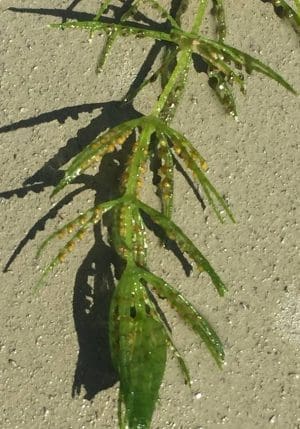Scientific name: Chara
Physical Characteristics
- Foul, musty – garlic-like odor giving muskgrass its name
- Gray-green branched multi-cellular algae that is often confused with submerged flowering plants
- Height can range from just under an inch to about 6.5 feet
- Has no flower
- Do not extend above the water surface
- Often has a “grainy” or “crunchy” texture due to calcium deposits and projections resembling thorns or spines on branchlets
- Has cylindrical, whorled branches with 6 to 16 branchlets around each node, but no true leaves
- Does not have roots, but can attach itself to the bottom of waterbodies via “holdfasts”
- Can form dense “meadows” on bottom
Where Does it Grow?
Chara grows in both shallow and deep brackish or freshwater, and prefers hard or alkaline waters. Spores or fragments of Chara are spread by current or waterfowl- due to this, Chara is often an early resident in new water bodies (or water bodies that appear in wet seasons).
Pros and Cons of Muskgrass
Chara is consumed by many species of ducks and provides habitat or shelter for invertebrates and small fish. Submerged portions of all aquatic plants provide habitats for many micro and macro invertebrates. These invertebrates in turn are used as food by fish and other wildlife species (e.g., amphibians, reptiles, ducks, etc.). After aquatic plants die, their decomposition by bacteria and fungi provides food (called “detritus”) for many aquatic invertebrates.
USDA, NRCS. 2018. The PLANTS Database (http://plants.usda.gov, 28 March 2018). National Plant Data Team, Greensboro, NC 27401-4901 USA.
Information and photos courtesy of AquaPlant A Diagnostics Tool for Pond Plants and Algae.

